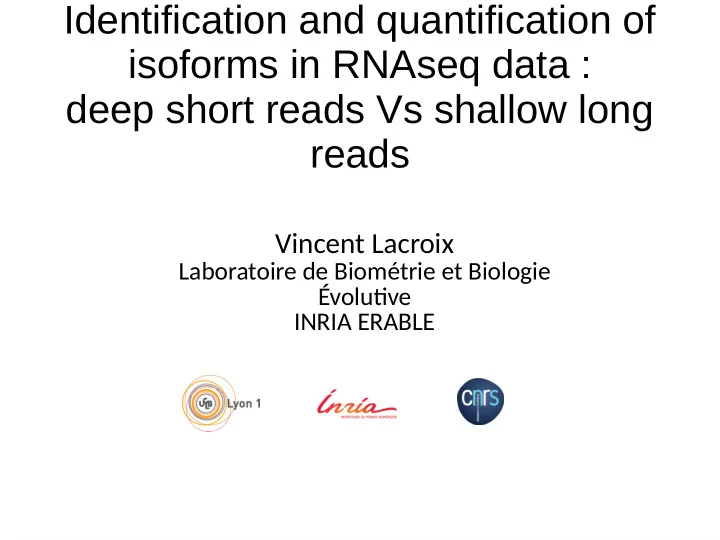

Identification and quantification of isoforms in RNAseq data : deep short reads Vs shallow long reads Vincent Lacroix Laboratoire de Biométrie et Biologie Évolutve INRIA ERABLE
What do we do in Lyon ● We are interested in developing bioinformatics methods to study alternative splicing ● KisSplice assembles AS events from short RNAseq reads efficiently. It is based on principled models and efficient data structures. ● It is available, maintained and used : www.kissplice.prabi.fr ● Question : when/how to move to long reads ?
RNAseq with Illumina mRNAs [500-5000nt] Reads Length : 100nt Number : 100M Error : 0.5 %
RNAseq with Nanopore mRNAs [500-5000nt] Reads Length : 1000nt Number : 1M Error : 10 %
Purpose of RNAseq ● Annotation – Identify and quantify all transcripts present in a given condition ● Differential analysis – Identify genes whose expression significantly changed across conditions – Identify exons whose inclusion levels significantly changed across conditions
ASTER Algorithms & software for 3rd generation RNA sequencing
Data generated by Genoscope ● Mouse brain / liver transcriptome – Nanopore cDNA : 1.2M reads – Illumina : 60M reads ● Using existing software, how can we analyse this dataset ? ● What are the open questions ?
Two mapping strategies ● Map to genome with minimap2 splice – 85 % of reads are mapped with 80 % query coverage ● Map to transcriptome with bwa-mem -x ont2d – 85 % of reads are mapped with 80 % query coverage
Example of EEF2 gene Reads are indeed quite long !
Example of EEF2 gene the staircase effect Many reads do not cover the full transcripts All reads cover the 3’end. This is due to cDNA synthesis which uses polydT primers.
De novo discovery of splice sites is not easy
Mapping to annotated splice sites is very easy Map To Genome Map To Transcriptome
Hard instances for a mapper Here the solution is to introduce a gap just before the splice site. These reads could be correctly aligned because we knew the positions of the splice sites Open question : how to align correctly when no annotations are available ? Our dataset can be used as a training set
Comparison with Illumina Illumina Nanopore Illumina reads are shorter There is more local heterogeneity of coverage
Comparison with Illumina (Sashimi Plot view) Illumina Nanopore
Some genes are not captured at all by Nanopore
Some alternative transcripts are not captured at all by Nanopore
Small exons are harder to find (hard instances for mapping ?) Exon size : 30nt
Novel exons are harder to find (hard instances for mapping ?) Illumina Nanopore map to Transcriptome Nanopore map to Genome Currently, no long read mapper correctly handles annotation
Summary on mapping ● There are still improvements to propose to map long reads, especially when no annotation is available ● However, the difference of depth between technologies (~50-100 fold) leads to missing many isoforms/genes
Quantification ● Each read corresponds to an individual mRNA molecule. ● Counting the number of reads is a proxy for the number of mRNAs ● There are 60X more reads with Illumina. Hence we sample 60X more mRNAs.
Quantification Illumina Vs Nanopore (mouse liver) Correlation is quite weak. R²=17 %. This means that 85 % in Nanopore read counts is not explained by Illumina. Some genes are detected as poorly expressed by Illumina and highly expressed by Nanopore Who is right ?
Quantification Illumina Vs Nanopore (mouse brain) The correlation is even weaker in brain, where more genes are poorly expressed
Spike-in data ● In order to know which technology gives the best quantification, we introduced in our samples transcripts in predefined quantities ● SIRV : Spike-In RNA Variants ● Lexogen E2 mix : 7 genes, 10 transcripts per gene, abudance varying from 1/32 to 1
Spike-ins (Illumina data from Lexogen)
Spike-in results (our cDNA Nanopore data) R=0.55,R²= 30 %, this means that 70 % of the variance is unexplained
Spike-in results Byrne et al. 2017 Nat Comm
Spike-in results Weirather et al. F1000
Quantification summary ● Illumina and Nanopore do not provide the same quantification ● The quantification by Nanopore is not so reliable, in particular for rare transcripts ● We are waiting for our spike-in Illumina data to have a full comparison ● RNA direct yet provides another quantification
Illumina Vs Nanopore ● Illumina is stronger for – Discovering Splice sites – Differential analysis (higher read counts --> more power) ● Nanopore is stronger for – Phasing exons
Summary Bioinformatics Developments ● Technology moves very fast ● Not clear how much time we should spend on bioinformatics development ● Many questions are still open on bioinformatics of splicing with Illumina data ● We aim at developping methods which take advantage of Illumina depth and Nanopore length ● How to efficiently use annotations is not easy
Various methods to find exon skipping from Illumina data
Bibliography
Other resources ● https://github.com/nanopore-wgs- consortium/NA12878/blob/master/RNA.md ● Minimap2 Vs gmap – http://complex.zesoi.fer.hr/index.php/en/blog-en/56- gmap-vs-minimap2
Acknowledgments ● All members from the Aster Project
Recommend
More recommend